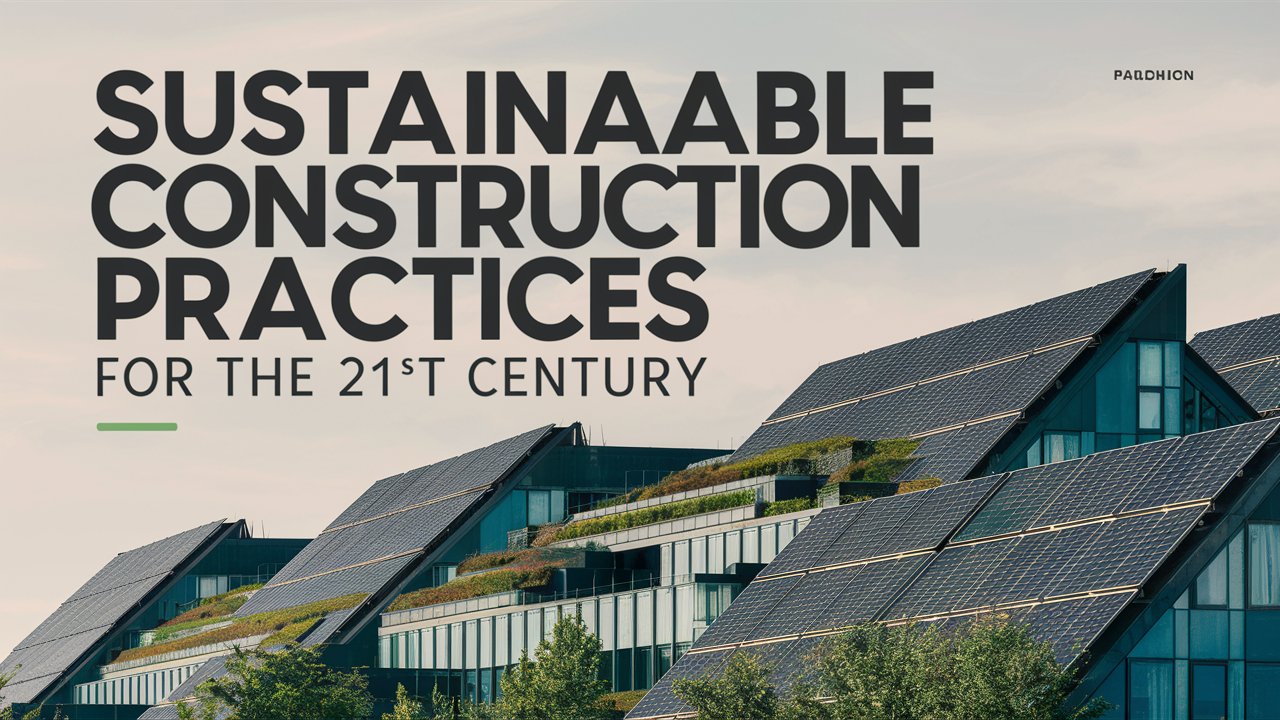As we move further into the 21st century, the construction industry faces increasing pressure to adopt more sustainable practices. It’s crucial that we rethink how we build our cities and infrastructure with growing concerns about climate change, resource depletion, and environmental degradation.
-
Green Building Materials
One of the cornerstones of sustainable construction is the use of eco-friendly building materials. These materials are typically renewable, recyclable, or have a lower environmental impact compared to traditional options. Some examples include:
- Bamboo: Fast-growing and strong, bamboo is an excellent alternative to wood for flooring and structural elements.
- Recycled steel: Using recycled steel reduces the need for new metal production, saving energy and resources.
- Hempcrete: A biocomposite made from hemp hurds and lime, hempcrete is lightweight, insulating, and carbon-negative.
Ready mix concrete (RMC) is another material that can contribute to sustainable construction when used thoughtfully. While traditional concrete production has a significant carbon footprint, innovations in concrete technology are making it more environmentally friendly. For instance, some manufacturers now incorporate recycled materials or industrial byproducts into their mixes, reducing waste and lowering the overall environmental impact.
-
Energy-Efficient Design
Sustainable buildings are designed to minimise energy consumption throughout their lifecycle. This involves several strategies:
- Passive solar design: Orienting buildings to maximise natural light and heat from the sun.
- High-performance insulation: Using advanced insulation materials to reduce heating and cooling needs.
- Smart windows: Implementing electrochromic or thermochromic glass that can adjust its tint based on sunlight intensity.
- Green roofs: Installing vegetation on rooftops to provide insulation and reduce urban heat island effects.
Read More Articles: The Fast-Track Solution to Modern Building Challenges
-
Water Conservation
Water scarcity is a growing concern in many parts of the world. Sustainable construction practices aim to reduce water usage and promote water recycling:
- Low-flow fixtures: Installing faucets, showerheads, and toilets that use less water without compromising functionality.
- Rainwater harvesting: Collecting and storing rainwater for non-potable uses like irrigation and toilet flushing.
- Greywater systems: Reusing lightly used water from sinks and showers for irrigation or toilet flushing.
-
Waste Reduction and Recycling
Construction and demolition waste accounts for a significant portion of landfill content. Sustainable practices focus on reducing this waste:
- Prefabrication: Building components off-site to minimise on-site waste and improve quality control.
- Deconstruction instead of demolition: Carefully dismantling buildings to salvage reusable materials.
- On-site recycling: Sorting and processing construction waste for reuse or recycling.
-
Smart Building Technologies
The integration of advanced technologies is making buildings more efficient and responsive to occupant needs:
- Building Management Systems (BMS): Centralised control systems that optimise heating, cooling, and lighting based on occupancy and external conditions.
- Internet of Things (IoT) sensors: Devices that monitor various aspects of building performance and occupant comfort.
- Artificial Intelligence (AI): Systems that learn from data to predict and optimise building operations.
-
Biophilic Design
Incorporating nature into building design not only improves sustainability but also enhances occupant well-being:
- Indoor plants: Using vegetation to improve air quality and create a more pleasant environment.
- Natural materials: Incorporating wood, stone, and other natural elements into the design.
- Views of nature: Designing buildings to maximise views of green spaces or water features.
-
Sustainable Site Selection and Development
The location and development of a construction site play a crucial role in overall sustainability:
- Brownfield redevelopment: Rehabilitating contaminated or previously developed sites instead of building on undisturbed land.
- Transit-oriented development: Locating buildings near public transportation to reduce reliance on personal vehicles.
- Preservation of natural habitats: Minimising disruption to local ecosystems during construction.
-
Life Cycle Assessment (LCA)
LCA is a comprehensive approach to evaluating the environmental impact of a building throughout its entire life cycle, from material extraction to demolition. This practice helps identify areas for improvement and guides decision-making in sustainable construction.
Table 1: Comparison of Traditional vs. Sustainable Construction Practices
| Aspect | Traditional Construction | Sustainable Construction |
| Materials | Virgin resources, high embodied energy | Recycled, renewable, low embodied energy |
| Energy Efficiency | Minimal consideration | Central focus, passive and active strategies |
| Water Usage | High consumption, minimal recycling | Low consumption, extensive recycling |
| Waste Management | Limited recycling, high landfill use | Extensive recycling, minimal landfill use |
| Indoor Environment | Limited consideration of occupant health | Prioritises occupant health and well-being |
| Site Impact | Often disruptive to local ecosystems | Minimises ecological disruption |
| Technology Integration | Basic systems | Advanced, smart technologies |
| Long-term Costs | Higher operational costs | Lower operational costs, higher initial investment |
As we continue to innovate in the field of sustainable construction, concrete remains a key material in many projects. However, its use is evolving to meet sustainability goals. For example, some companies are developing ready mix concrete that incorporates carbon capture technology, effectively storing CO2 within the concrete itself. This innovative approach not only reduces the carbon footprint of construction but also improves the strength and durability of the concrete.
-
Certifications and Standards
Various certification systems have emerged to guide and recognise sustainable construction practices:
- LEED (Leadership in Energy and Environmental Design): A widely recognised green building certification program.
- BREEAM (Building Research Establishment Environmental Assessment Method): An assessment method for master-planning projects, infrastructure, and buildings.
- Living Building Challenge: A rigorous performance standard where projects must meet a series of ambitious performance requirements over a minimum of 12 months of continuous occupancy.
Read More Articles: Essential Guidelines for Creating a Safe Construction Site
-
Community and Social Sustainability
Sustainable construction isn’t just about environmental impact; it also considers social and economic factors:
- Affordable housing: Incorporating sustainable design into affordable housing projects to ensure equitable access to green buildings.
- Job creation: Promoting local employment and skills development in sustainable construction techniques.
- Community engagement: Involving local communities in the planning and design process to ensure projects meet their needs and aspirations.
-
Resilient Design
As climate change leads to more extreme weather events, sustainable construction must also focus on resilience:
- Flood-resistant design: Elevating buildings or using water-resistant materials in flood-prone areas.
- Wind-resistant construction: Implementing structural designs that can withstand high winds in hurricane-prone regions.
- Earthquake-resistant buildings: Using flexible structures and base isolation techniques in seismic zones.
Conclusion
The construction industry is at a pivotal point in its evolution. The adoption of sustainable practices is no longer just an option but a necessity for the future of our planet and communities. From innovative materials like advanced ready-mix concrete to advanced technologies and holistic design approaches, the tools for sustainable construction are constantly improving.
Don’t let your construction project fall behind in the sustainability revolution. Partner with Pro-Mix Concrete and build a greener future, one project at a time. Contact us now




